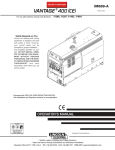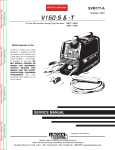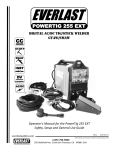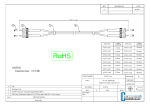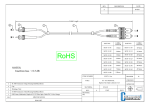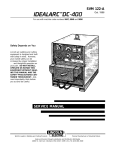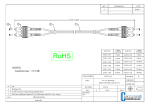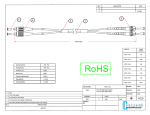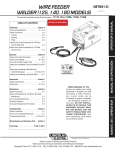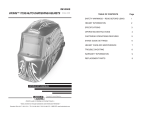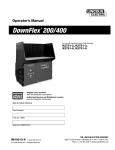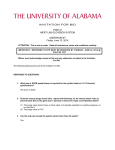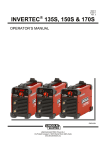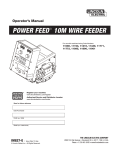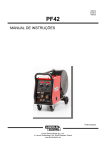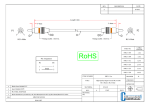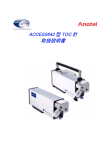Download POWERWAVE C300
Transcript
SVM1XX-A View Safety Info Return to Master TOC RETURN TO MAIN INDEX X, 2009 POWERWAVE C300 For use with machine code number: 111XX Return to Master TOC View Safety Info Return to Master TOC View Safety Info Safety Depends on You Lincoln arc welding and cutting equipment is designed and built with safety in mind. However, your overall safety can be increased by proper installation . . . and thoughtful operation on your part. DO NOT INSTALL, OPERATE OR REPAIR THIS EQUIPMENT WITHOUT READING THIS MANUAL AND THE SAFETY PRECAUTIONS CONTAINED THROUGHOUT. And, most importantly, think before you act and be careful. View Safety Info Return to Master TOC SERVICE MANUAL Copyright © Lincoln Global Inc. • World's Leader in Welding and Cutting Products • • Sales and Service through Subsidiaries and Distributors Worldwide • Cleveland, Ohio 44117-1199 U.S.A. TEL: 216.481.8100 FAX: 216.486.1751 WEB SITE: www.lincolnelectric.com INSTALLATION Return to Master TOC Return to Master TOC Return to Section TOC Return to Section TOC 2 SHIELDING GAS CONNECTION WARNING CYLINDER may explode if damaged. • Keep cylinder upright and chained to support. • Keep cylinder away from areas where it may be damaged. • Never lift welder with cylinder attached. • Never allow welding electrode to touch cylinder. • Keep cylinder away from welding or other live electrical circuits. • BUILD UP OF SHIELDING GAS MAY HARM HEALTH OR KILL. • Shut off shielding gas supply when not in use. • See American National Standard Z-49.1, "Safety in Welding and Cutting” Published by the American Welding Society. -----------------------------------------------------------------------MAXIMUM INLET PRESSURE IS 100 PSI. (6.9 BAR.) Install the shielding gas supply as follows: 1. Secure the cylinder to prevent it from falling. 2. Remove the cylinder cap. Inspect the cylinder valves and regulator for damaged threads, dirt, dust, oil or grease. Remove dust and dirt with a clean cloth. DO NOT ATTACH THE REGULATOR IF OIL, GREASE OR DAMAGE IS PRESENT! Inform your gas supplier of this condition. Oil or grease in the presence of high pressure oxygen is explosive. 3. Stand to one side away from the outlet and open the cylinder valve for an instant. This blows away any dust or dirt which may have accumulated in the valve outlet. 4. Attach the flow regulator to the cylinder valve and tighten the union nut(s) securely with a wrench. Note: if connecting to 100% CO2 cylinder, insert regulator adapter between regulator and cylinder valve. If adapter is equipped with a plastic washer, be sure it is seated for connection to the CO2 cylinder. 5. Attach one end of the inlet hose to the outlet fitting of the flow regulator. Attach the other end to the welding system shielding gas inlet. Tighten the union nuts with a wrench. 6. Before opening the cylinder valve, turn the regulator adjusting knob counterclockwise until the adjusting spring pressure is released. 7. Standing to one side, open the cylinder valve slowly a fraction of a turn. When the cylinder pressure gage stops moving, open the valve fully. 8. The flow regulator is adjustable. Adjust it to the flow rate recommended for the procedure and process being used before making a weld. POWER WAVE® C300’s internal gas connection should be connected to wire drive’s gas connection. Return to Section TOC Return to Master TOC Return to Master TOC FIGURE A.4 Return to Section TOC 2 ENTERNAL GAS CONNECTION FOR GMAW PROCESS POWERWAVE C300 INSTALLATION Return to Master TOC Return to Section TOC 3 TIG WELDING 3 SMAW WELDING (Figure A.7) Tig uses Electrode Negative Polarity so for this application, connect the Tig torch to the negative (-) output stud and connect the work clamp to the positive (+) output stud. The TIG torches gas connection should be connected to the POWER WAVE® C300’s internal gas supply connection. If required a foot amptrol can be connected to the remote control receptacle. Most SMAW welding procedures use Electrode Positive welding. For these applications, connect the stick electrode holder to the positive (+) output stud and connect the work clamp to the negative (-) output stud. Some SMAW welding procedures does use Electrode Negative Polarity. For these applications, connect the stick electrode holder to the negative (-) output stud and connect the work clamp to the positive (+) output stud. Return to Master TOC Return to Section TOC FIGURE A.7 SPOOL GUN / PUSH PULL RECEPTACLE REMOTE CONTROL RECEPTACLE POSITIVE STUD (+) Return to Master TOC Return to Section TOC GAS SUPPLY CONNECTION NEGATIVE STUD (-) TO POSITIVE STUD (+) WORK CLAMP WORK PIECE TO NEGATIVE STUD (-) Return to Master TOC Return to Section TOC POWER CABLE TO GAS SUPPLY CONNECTION TIG TORCH GAS HOSE TO REMOTE CONTROL RECEPTACLE FOOT AMPTROL (OPTIONAL) POWERWAVE C300 OPERATION Return to Master TOC Return to Section TOC 4 4 CASE FRONT CONTROLS (Code 11479) FIGURE B.1 1 2 Return to Master TOC Return to Master TOC Return to Master TOC Return to Section TOC Return to Section TOC Return to Section TOC 3 4 10 5 11 6 12 7 13 8 14 15 9 All operator controls and adjustments are located on the case front of the Power Wave. (See Figure B.1) 9. ON/OFF SWITCH- Controls power to the Power Wave® C300. 1. LEFT DISPLAY- Shows wire feed speed or amperage, 10. RIGHT DISPLAY- Shows voltage or trim. 2. LEFT KNOB- Adjusts value in left display. 11. THERMAL LIGHT- Indicates when machine has thermal fault. 12. RIGHT KNOB- Adjusts value in right display. 3. MAIN DISPLAY- Shows detailed welding and diagnostic information. 13. SET-UP- Lights when machine is in set-up mode, 4. LEFT BUTTON- Changes the Main display to show the Weld Mode or Arc Control. 14. IR PORT- Used to transfer information to palm computers, etc. 5. MAIN KNOB- Changes the values on the Main display. 15. RIGHT BUTTON- Used to toggle start options and to end options. 6. PROCEDURE BUTTON- Selects A or B procedure, or gun control. 7. 2-STEP/4-STEP BUTTON- Toggles between 2-step and 4-step trigger operation. 8. MEMORIES BUTTONS- For selection of common procedures. POWERWAVE C300 Return to Section TOC Return to Master TOC Return to Section TOC Return to Master TOC Return to Section TOC Return to Master TOC Return to Master TOC Return to Section TOC 5 OPERATION CASE BACK CONTROLS (Code 11479) FIGURE B.2 1 2 3 1. ETHERNET CONNECTOR 2. GAS CONNECTION 3. POWER CORD POWERWAVE C300 5 OPERATION Return to Master TOC Return to Master TOC Return to Section TOC Return to Section TOC 6 INTERNAL CONTROLS (Code 11479) FIGURE B.3 2 4 5 6 7 Return to Master TOC 9 10 11 12 1. SPINDLE BRAKE 7. POSITIVE STUD 2. WIRE DRIVE PRESSURE ARM 8. GAS CONNECTION 3. THUMB SCREW, FOR SECURING THE WELDING GUN 9. NEGATIVE STUD 4. GUN BUSHING 10. COLD INCH / GAS PURGE SWITCH 5. SOCKET HEAD CAP SCREW FOR SECURING THE GUN BUSHING 11. 6-PIN CONNECTOR FOR REMOTE CONTROL OPTIONS 6. 4-PIN TRIGGER RECEPTACLE 12. 7-PIN CONNECTOR FOR PUSH / PULL OR SPOOL GUN OPTIONS Return to Master TOC Return to Section TOC 1 3 8 Return to Section TOC 6 POWERWAVE C300 OPERATION Return to Master TOC Return to Section TOC 7 7 CASE FRONT CONTROLS USED WIRE FEED SPEED (WFS) AMPS + LESS AMPS + MORE AMPS OUTPUT OFF VOLTS TRIM OUTPUT ON Return to Section TOC Return to Master TOC Return to Master TOC Return to Master TOC IR PORT Return to Section TOC Return to Section TOC SETUP WELD MODE START OPTIONS UltimArc™ Control END OPTIONS DUAL PROCEDURE/ MEMORY PANEL OPERATION POWERWAVE C300 OPERATION Return to Master TOC Return to Section TOC 8 ALUMINUM SYNERGIC GMAW-P (PULSED MIG)AND GMAW-PP (PULSE ON PULSE) WELDING The Power Wave® C300 can produce top quality aluminum welds with excellent appearance, little spatter and good bead shape. Push-pull guns are available for consistent feeding when welding a long distance away from the wire feeder. Return to Master TOC Return to Section TOC PULSE-ON-PULSE WELDING The Power Wave system offers both traditional pulse and Pulse-on-Pulse™. Pulse-on-Pulse (GMAW-PP) is an exclusive waveform for aluminum welding. Use it to make welds with a "stacked dime" appearance, similar to GTAW welds.( See Figure B.7) FIGURE B.7 8 ALUMINUM GMAW-P AND GMAW-PP ALUMINUM PULSE WELDING Synergic GMAW-P (Pulsed MIG) welding is ideal for low spatter, out of position and reduced heat input applications. During pulse welding, the welding current continuously switches from a low level to a high level and then back again. Each pulse sends a small droplet of molten metal from the wire to the weld puddle. Pulse welding controls the arc length with 'Trim' instead of voltage. When trim (arc length) is adjusted, the Power Wave automatically recalculates the voltage, current and time of each part of the pulse waveform for the best result. Trim adjusts the arc length and ranges from 0.50 to 1.50, with a nominal value of 1.00 for a 3/4" (19mm) electrode stick-out. Trim values greater than 1.00 increase the arc length, while values less than 1.00 decrease the arc length. (See Figure B.10) FIGURE B.10 Return to Master TOC Return to Section TOC The pulsing frequency is adjustable. Changing the frequency modulation (or arc control) of the waveform changes the ripple spacing. Faster travel speeds may be achieved by using higher values of frequency modulation. ( See Figure B.8 and B.9p) Trim .50 Arc Length Short FIGURE B.8 Frequency Modulation = -10 Wide weld and ripple spacing, slow travel speed. Return to Master TOC Return to Section TOC FIGURE B.9 Frequency Modulation = 10 Narrow weld and ripple spacing, fast travel speed. POWERWAVE C300 Trim 1.00 Arc Length Medium Trim 1.50 Arc L ength Long OPERATION Return to Master TOC Return to Section TOC 9 If the passcode does not equal zero (0000), enter the passcode now. If the passcode has been forgotten, a p.c. computer application or Palm O.S. application is required to change the passcode. Memory Value Low Limit 200 High Limit 9 The memory value must always be less than or equal to the high limit, and greater than or equal to the low limit. After setting limits, press the memory button with the flashing LED. The MSP4 will ask to save or discard the limit changes just made. Press the left MSP4 for button (YES) to save and enable the limits and exit. Press the right MSP4 button (NO) to exit and leave limits unchanged. SETUP HI = 200 LO = 180 WELD WFS IR PORT Enabling/Disabling Limits START OPTIONS WELD MODE UltimArc™ Control Enable/Disable Limits: Press 10 seconds END OPTIONS Return to Master TOC Return to Master TOC Return to Section TOC Return to Section TOC Parameter Name A If the passcode has been set to zero (0000), SETUP will illuminate on the MSP4 panel and the display will show the following: Four items show on the MSP4 panel. • Memory Value • High Limit • Low Limit • Parameter Name One of these items will flash to indicate which item will change when the MSP4 encoder is rotated. Press the right button on the MSP4 panel to select the item to change. 200 Return to Master TOC IR PORT M M 1 2 3 4 5 6 7 8 Limits for each memory may be enabled or disabled by pressing and hold the appropriate memory button for 10 seconds. Release the memory button when the MSP4 display shows the following: MEMORY 2 LIMITS ENABLE / DISABLE SETUP HI = 200 LO = 180 WELD WFS SETUP IR PORT START OPTIONS WELD MODE UltimArc™ Control END OPTIONS START OPTIONS WELD MODE UltimArc™ Control END OPTIONS If the passcode does not equal zero, enter the passcode now. If the passcode is zero (0000), SETUP will light and the MSP4 displays the following: Rotate to Change Value. Return to Section TOC GUN B Press to select item to change. The Limits Setup menu shows a list of all parameters available for the weld mode stored in the memory chosen. For example, if limits are being set for a stick (SMAW) mode, parameters such as Run-in WFS and Postflow will not appear. To lock a parameter to a specific value that cannot be changed, set the high and low limits to the same value. ENABLE LIMITS? Yes No WELD MODE UltimArc™ Control SETUP IR PORT START OPTIONS END OPTIONS Press the left MSP4 button (YES) to enable limits or the right MSP4 button (NO) to disable limits. Disabling limits does not change any limits values that may have been previously set. POWERWAVE C300









